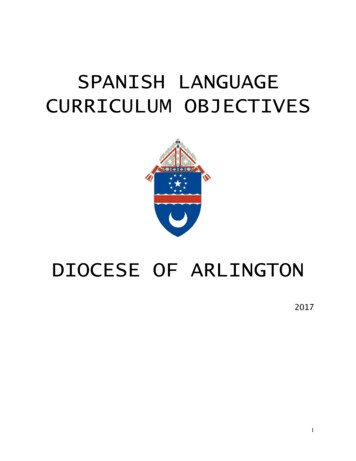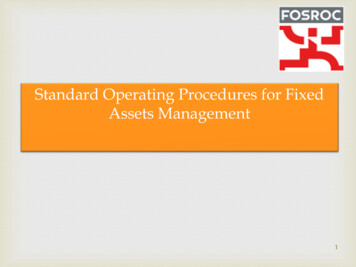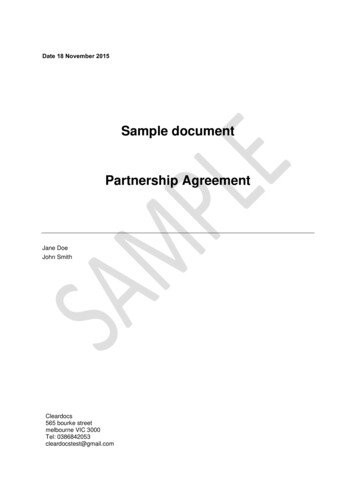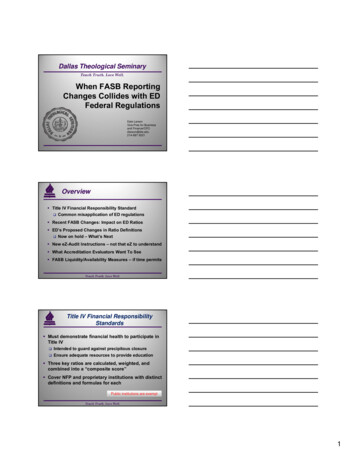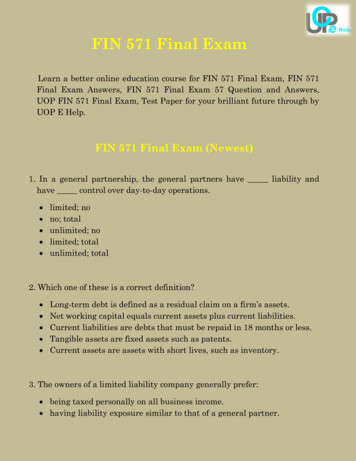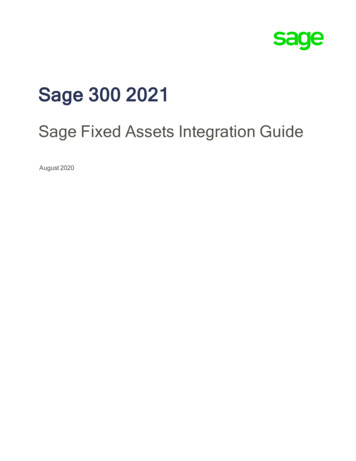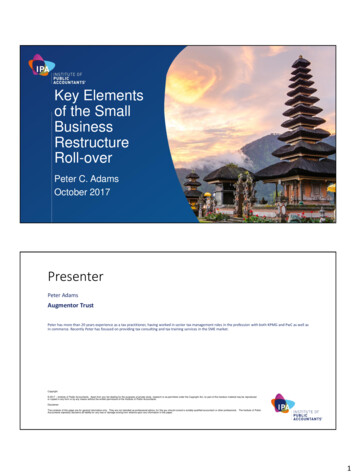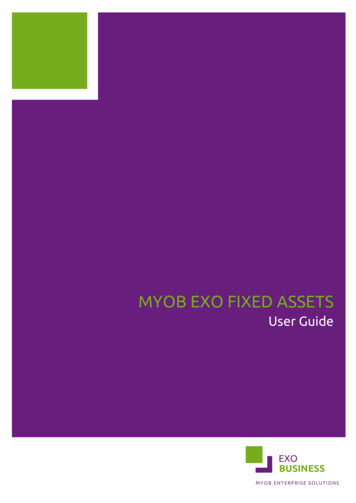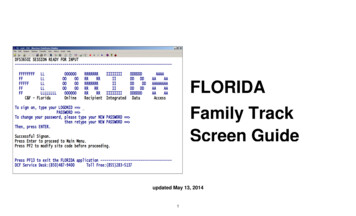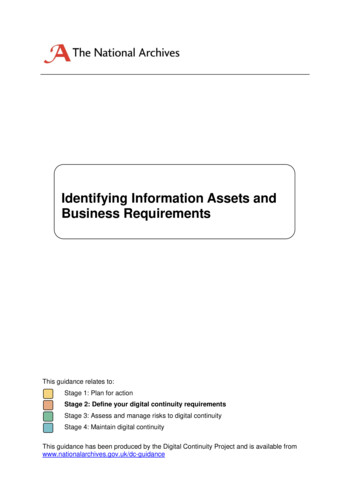
Transcription
Identifying Information Assets andBusiness RequirementsThis guidance relates to:Stage 1: Plan for actionStage 2: Define your digital continuity requirementsStage 3: Assess and manage risks to digital continuityStage 4: Maintain digital continuityThis guidance has been produced by the Digital Continuity Project and is available fromwww.nationalarchives.gov.uk/dc-guidance
The National ArchivesInformation Assets and Business Requirements Version: 1.2 Crown copyright 2011You may re-use this document (not including logos) free of charge in any format or medium,under the terms of the Open Government Licence. To view this licence, overnment-licence/open-governmentlicence.htm or write to the Information Policy Team, The National Archives, Kew, Richmond,Surrey, TW9 4DU; or email: psi@nationalarchives.gsi.gov.uk .Any enquiries regarding the content of this document should be sent e 2 of 25
The National ArchivesInformation Assets and Business Requirements Version: 1.2Contents12.3.4.Introduction . 41.1What is the purpose of this guidance? . 41.2Helping you manage digital continuity . 51.3Who is this guidance for? . 5Setting your objectives . 72.1Managing digital continuity . 72.2Change management . 82.3Managing risks and improving governance . 82.4Managing retention and disposal . 92.5Exploiting and sharing information. 92.6Streamlining technology . 9Identify what information assets you have .103.1What is an information asset? .103.2How do you identify an information asset? .10Identify how you need to use your information .134.1How will you find the information? .134.2Who can access the information and how? .144.3What do you need to be able to do with the information? .144.4What do you need to be able to understand about the information? .154.5To what extent do you need to trust your information is what it claims to be? .165. Documenting the relationships between business requirements and informationassets .176.5.1Creating or adapting an IAR .175.2Identify owners of the information asset .185.3Maintaining and updating the IAR.19Next steps .206.1Map to technology dependencies .206.2Understand your information management requirements .206.3Identify and mitigate risks .216.4Identify opportunities for disposal, exploitation, savings and efficiencies .216.5Manage change .216.6Supporting services .22Appendix – Scenarios .23Page 3 of 25
The National Archives1Information Assets and Business Requirements Version: 1.2IntroductionHow much digital information does your organisation hold? Who takes care of it?The amount of information organisations create is continually increasing, and whether yourorganisation is large or small, if you do not understand your information, you cannot fullyprotect and exploit it. This guidance describes a practical process to enable you tounderstand, assess and document your information and make sure that it supports yourbusiness appropriately.1.1 What is the purpose of this guidance?This piece of guidance focusses on understanding the information your organisation holdsand how it needs to be used to support your business. Developing this understanding willsupport you in effectively managing your information assets through change.This guidance will enable you to: understand your business drivers for this investigation and frame your objectivesaccordingly identify your information assets understand your business requirements for using information document the relationships between your business requirements and yourinformation assets in a way that supports your objectives.The reasons, or ’drivers’, for undertaking this investigation can vary and therefore lead tovaried scopes and objectives, from large scale audits of all of your organisation’s information,to very focussed assessments for a specific change in technology or business.Regardless of what your drivers are for carrying out this study, there are multiple benefitswhich can have a wider reaching impact than your original scope. These include betterchange management, improved understanding of information risk and identification ofpotential savings and efficiencies.Page 4 of 25
The National ArchivesInformation Assets and Business Requirements Version: 1.21.2 Helping you manage digital continuityAlthough this guidance contributes to overall good information management and can be usedto meet a number of different objectives, one of the key objectives it supports is bettermanagement of your digital continuity.Digital continuity is the ability to use your information in the way you need, for as long as youneed. Managing digital continuity protects the information you need to do business. Thisenables you to operate accountably, legally, effectively and efficiently. It helps you to protectyour reputation, make informed decisions, avoid and reduce costs, and deliver better publicservices. If you lose information because you haven't managed your digital continuityproperly, the consequences can be as serious as those of any other information loss.This guidance forms part of a suite of guidance1 that The National Archives has delivered aspart of a digital continuity service for government, in consultation with central governmentdepartments. This specific piece provides you with practical information and support to helpyou complete Stage 2 of the four-stage process of managing digital continuity.2 Stage 2 is allabout understanding your business requirements for information use and how yourinformation assets and technical environment support those requirements, now and in thefuture. This knowledge can then be used to perform a risk assessment and then take action– establishing processes, making savings and efficiencies and minimising your risk.We suggest breaking this process into two halves. The first half of this process (identifyingyour information assets and mapping them to your business requirements) is covered in thispiece of guidance. An accompanying piece of guidance, Mapping the TechnicalDependencies of Information Assets3 covers the second half of this process.1.3 Who is this guidance for?The audience for this piece of guidance will vary depending on the drivers for performing theinvestigation. For digital continuity, the primary audience will be the Senior ResponsibleOwner (SRO) and whoever the SRO has assigned to be responsible for completing Stage 21For more information and guidance, visit nationalarchives.gov.uk/dc-serviceSee Managing Digital Continuity ement/managing-digital-continuity.pdf3See Mapping the Technical Dependencies of Information Assets nationalarchives.gov.uk/dcguidance.2Page 5 of 25
The National ArchivesInformation Assets and Business Requirements Version: 1.2of the process. If the driver is to perform an impact study for a potential change, then it maybe a change or project manager using this guidance.Regardless of their role, the person leading the process will likely have to consult othermembers of the organisation who may also find it useful to read this piece to understand thebackground – for example business continuity managers, Information Asset Owners, ITprofessionals and business analysts.Page 6 of 25
The National Archives2.Information Assets and Business Requirements Version: 1.2Setting your objectivesYou need to be very clear about why you are looking at your information, what your reasonsare for starting the investigation and what you hope to achieve from it. Your own driver maybe reactive – an incident has occurred (for example a badly managed change, or a loss ofdata) and you want to ensure it does not happen again. On the other hand, the driver may bemore preventative – your organisation is preparing to go through a specific change (businessor technical) and you want to make sure you have the necessary understanding to bestprotect your digital information.These different drivers will give you different objectives, and will therefore direct the scaleand scope of your investigation. For example, do you need to do this evaluation for yourentire organisation, or just for a discrete business unit within it?While it is important to eventually review all your information, unless you are a smallorganisation with a relatively low amount of digital information, trying to capture everything indetail at once is likely to be an overwhelming task. It is far better to have realistic objectivesprioritising key areas you want to look at, and focus on other areas later.You must ask yourself questions about what you are trying to achieve and what yourpriorities should be – what do you want to do with the information you are going to gather,what can you practically achieve, what risks do you need to mitigate, what benefits do youhope to achieve, and what areas need the most urgent attention?The following sections 2.1-2.6 give examples of some high-level objectives:2.1 Managing digital continuity“We want to better manage the digital continuity of our information – so that we canuse it in the way we need to over time.”If you are working through the four stages of the managing digital continuity process,establishing your scope and priorities is an important part of Stage 1 and is covered in moredetail in Managing Digital Continuity.44See Managing Digital Continuity ement/managing-digital-continuity.pdfPage 7 of 25
The National ArchivesInformation Assets and Business Requirements Version: 1.2However, even if you are not specifically working through the four stages of that process,better understanding of your assets and their requirements will automatically improve yourdigital continuity. You have digital continuity if your information is complete, available andtherefore usable in the way you need it to be. To manage your digital continuity, you mustfirst understand your business requirements, how you need to use your information to meetthose requirements and what functionality your technology environment needs to provide.2.2 Change management“Our organisation is planning a change and we want to make sure we understandwhat information we have, and how to manage it through the transition.”It may be that a driver for this work is that your organisation is going through a change, eitheran organisational one such as a restructuring, or a technological one such as upgrading akey system. It may also be that there is no specific change at the moment, but you want tointroduce or improve a change management process and be prepared for the future.Change is a major threat to your information (it is the key risk to digital continuity) and animportant time to consider what information assets you actually have and how you canprotect and exploit them. During change it is very easy for things to move out of alignment,for technology to stop supporting the use of your assets in the way that you need, or yourinformation assets to fail to provide the data that new business requirements call for.2.3 Managing risks and improving governance“Our organisation wants to better understand risks and mitigate them throughimproved governance and processes.”This work will allow you to better understand how to manage your information and how tomitigate risks. You may opt to look at a subset of risks (e.g. risks to digital continuity orinformation security, or risks arising from change) or risks to specific areas of information.The specific risks you look at may depend on your risk appetite, for example risks toinformation which is business critical are likely to be a priority. It is important to understandyour obligations – for example in regards to the Data Protection Act, or confidentialityrequirements where you may incur penalties if problems occur.Page 8 of 25
The National ArchivesInformation Assets and Business Requirements Version: 1.22.4 Managing retention and disposal“Our organisation wants to audit our information so we know what we need to keep,how we can store it efficiently and what we can dispose of.”Digital information is being created at an ever-increasing rate, and this can lead to rising datastorage costs and more and more difficulty in finding information. It is becoming ever moreimportant to carefully consider what you need to keep and how you need to be able toaccess it.5 Understanding this allows you to define retention schedules and safe processesfor disposal. This can lead to reductions in the amount of storage required, leading to costefficiencies and contributing to green agendas.2.5 Exploiting and sharing information“Our organisation wants to understand what information we can share and how wecan do it.”The government agenda on transparency makes it very clear that opening data up is a keypriority wherever possible. In order to best exploit and share your information both withinyour own organisation, between related organisations and with the wider public, it is vital youfirst understand your information. Going through this process will put you in a position whereyou fully understand what information you have and what you can and cannot do with it. Thiswill also allow you to respond more easily and quickly to requests for information.2.6 Streamlining technology“Our organisation wants to better understand our technology systems and whether wecan streamline them without losing functionality.”Once you have evaluated your information assets, you can map them to the technologysupport they need. If you perform a comprehensive audit, you will confidently be able toidentify surplus technology which could be decommissioned leading to savings. This processis covered in Mapping the Technical Dependencies of Information Assets.65See ‘What to keep’ guidance on The National Archives website ects-and-work/what-to-keep.htm6See Mapping the Technical Dependencies of Information e 9 of 25
The National Archives3.Information Assets and Business Requirements Version: 1.2Identify what information assets you have3.1 What is an information asset?In order to understand your information and how to manage and protect it, it is vital to firstunderstand what we mean by the term ‘information asset’ and how this definition can simplifythe process.An information asset is a body of information, defined and managed as a singleunit so it can be understood, shared, protected and exploited effectively.Information assets have recognisable and manageable value, risk, content andlifecycles.The key concept here is to group your individual pieces of information into manageableportions; if you had to individually assess every individual file, database entry and piece ofdata you hold you would likely have a list of millions of items and an impossible task. Bygrouping items at a level to match your objectives you can make the task actually achievable.3.2 How do you identify an information asset?You should identify your assets according to the definitions above, considering the level ofgranularity that is required to meet your objectives. An information asset is defined at a levelof detail that allows its constituent parts to be managed usefully as a single unit.The case studies in the Appendix provide some examples of how different objectives can bemet by varying the granularity of your information assets.To perform this audit, you will need to talk to representatives from all sections of yourorganisation to ensure you have covered all aspects of your business. Your organisation mayalready have resources you can use to help in this process, for example documentation ofprevious information audits, technical environment registers, configuration managementdatabases or software asset lists. You may also have Information Asset Owners (IAOs), arole which was identified by the Data Handling Review and mandated by the Cabinet Office.77Cabinet Office Guidance on the Mandatory Role of the IAOwww.cabinetoffice.gov.uk/media/204709/iao role.pdf and The National Archives’ ion-management/role-of-the-iao.pdfPage 10 of 25
The National ArchivesInformation Assets and Business Requirements Version: 1.2You should investigate these resources and re-use and adapt them wherever possible.However they may only be a very basic foundation to start from and there will almostcertainly be additional information you will need to gather.It is probably easiest to start with very broad definitions and then continue splitting theinformation grouping up until it is of a suitable size. To assess whether something is aninformation asset, ask the following questions: Does it have a value to the organisation? Will it cost money to reacquire theinformation? Would there be legal, reputational or financial repercussions if youcouldn’t produce the information on request? Would it have an effect on operationalefficiency if you could not access the information easily? Would there beconsequences of not having this information? Is there a risk associated with the information? Is there a risk of losing theinformation? A risk that the information is not accurate? A risk that someone may tryto tamper with it? A risk arising from inappropriate disclosure? Does the group of information have a specific content? Do you understand what it isand what it is for? Does it include all the context associated with the information? Does the information have a manageable lifecycle? Were all the components createdfor a common purpose? Will they be disposed of in the same way and according tothe same rules?Examples: Information assetA database of contacts is a clear example of a single information asset. Each entry in thedatabase does not need to be treated individually; the collection of pieces of data cantherefore be considered one information asset. All the pieces of information within the assetwill have similar risks associated with privacy and storage of personal information.All files associated with a specific project may be considered a single information asset. Thismight include spreadsheets, documents, images, emails to and from project staff and anyother form of records. All the individual items can be gathered together and treated the sameas they have similar definable content, and the same value, business risk and lifecycle.Depending on the size of your organisation, you may be able to treat all the content in yourelectronic document and records management system as a single asset – but this could be arisk as such a large asset containing varied types of content is likely to be hard to manage.All the financial data for an organisation could be considered a single asset. There are veryspecific risks to the business if this information is mismanaged and you may also have anobligation to provide transparency of information, which could be problematic.Page 11 of 25
The National ArchivesInformation Assets and Business Requirements Version: 1.2Note: Information assets should be grouped and considered depending on their businessneeds not on their technology requirements. Each asset may contain individual itemsthat need different technology solutions to address the same business need. It may be that a piece of information could logically belong within two different assets,however this can lead to conflicts of ownership and control, so ideally each piece ofinformation should only be included within in a single asset. However assets canreference other assets and care should be taken to manage these potentiallycomplex relationships. Assets can contain other assets – as you introduce more and more granularity, it maybe useful to retain the sense of the high-level assets. Your organisation must defineclear rules about how the management and retention schedules of these assetsoperate at these different levels. The groupings of information within assets may change over time. For example, youmay have an asset which contains all the items archived into long term storage,therefore other pieces of information will be added into this asset over time.This can be a complicated process, but done properly can be of real, lasting benefit to yourorganisation. There is no right or wrong way to group your assets. The key point toremember is that you are doing all of this within the scope defined by your objectives and ifthe list you produce is consistent and relevant, then it meets your objectives.Page 12 of 25
The National Archives4.Information Assets and Business Requirements Version: 1.2Identify how you need to use your informationOnce you have identified your information assets, you must determine how you need to useeach of them. This covers everything from how you find it, through how you access it to whatyou do with it. You must also consider any surrounding or supporting information which isimportant. We have broken this down into five questions you will need to answer:1) How will you find the information?2) Who can open the information and how?3) How do you need to be able to work with the information?4) What do you need to be able to understand about your information?5) To what extent do you need to trust that your information is what it claims to be?For each of these issues you must consider what the requirements are at the moment, andhow they might change over time. This will encompass the retention schedules imposed onyour assets – how long do you need them for?These questions also form the core of digital continuity – what usability you need to maintainfor your information over time and through change. If you lose the ability to find, open, workwith, understand and trust your information in the way that you need, you have lost its digitalcontinuity.Note it is possible that in defining these requirements you may want or need to re-define yourinformation assets – this may well be an iterative process. If the contents of your asset havedramatically different requirements in any of these areas, you may need to further subdivideyour assets.4.1 How will you find the information?The granularity and depth of the search required will depend on the type of asset; it mayinvolve finding the asset itself, searching within the asset for files, or searching within thosefiles to find specific pieces of data.Page 13 of 25
The National ArchivesInformation Assets and Business Requirements Version: 1.2Examples of requirements: It must be possible to find generic information from the system withoutreferencing specific names, in order to meet privacy requirements. It must be possible to search within the asset to find files created within aspecific date range. Any requests for information from the system will always be requestedthrough a system engineer, non-experts will not need to search within it.It is important to consider these requirements because they impact upon how you store theasset and any technology used for searching and indexing.4.2 Who can open the information and how?These requirements cover not only the security issues around people gaining access torestricted or private information, but also the opportunities for sharing information internallyand more widely.Examples of requirements: The individual files inside the asset are private and only the person thatcreated the file should be able to open it. Everything within the asset is protectively marked, only those with the rightclearance should be able to open it. The information within the asset should be published openly. It must be possible to release individual items inside the asset within 20working days of a request.The benefits of ensuring the security of your information is protected are obvious. However,by considering the additional aspects of sharing you will be well placed to meet your targetsunder the government’s agenda on transparency, improving the efficiency of storage, andpotentially even reducing the likelihood of duplication of work between and withindepartments.4.3 How do you need to be able to work with the information?This is where you define the functionality that you require from your information assets, howyou use them and what you need them to do. This area may overlap with the openPage 14 of 25
The National ArchivesInformation Assets and Business Requirements Version: 1.2requirements in that there may be different groups of users who need to access the assets indifferent ways.Examples of requirements: The information must be editable (this may involve using original sourcefiles) The information must be available for disabled users, in formats suitable forscreen readers, for example. The creator of the document must have full write access. Everyone elseshould have read-only access. The formulae and functions inside the information must be maintained sothey can be updated. It is not sufficient to only be able to access the data.itself.These requirements describe the functionality that your technology must provide, so byunderstanding these features you may be able to streamline your software.4.4 What do you need to be able to understand about the information?This is about understanding the content and context of your information asset. This additionalinformation is not necessarily included within the asset itself but is vital to making the assetusable. The information may be stored digitally as metadata, but it may also be specificknowledge held by individuals, which may involve training or handover procedures if staffchange.Examples of requirements: The information within this asset contains references and links to thecontent of another named information asset. The asset is a large collection of files which must be kept within the currentstructure, flattening the file structure would confuse the meaning of the files. The information asset was created under a specific set of circumstanceswhich must be recorded. There is a complex version history which must be maintained, it should bepossible to access the information as it was at any specified date.Page 15 of 25
The National ArchivesInformation Assets and Business Requirements Version: 1.2The filing system within the asset is complex, but undocumented, so those filing andretrieving information from within the asset must be trained in how to use it.These requirements will help you to understand how your assets interact and allow you toensure they continue to be usable over time.4.5 To what extent do you need to trust your information is what it claims tobe?The level of trust required of an asset will vary considerably. The majority of your assets maywell not require any additional validation – they speak for themselves. However for othersyou may have to prove they have not been tampered with, or to certify them as created on aspecific date.Examples of requirements: All access to the contents of the asset must be recorded. Must be able to verify the integrity of a dataset – that nothing has beeninserted into it. All previous versions of the contents of the asset must be maintained andaccessible.These requirements are particularly important because they cover your legal requirementsand there may be serious repercussions if they are not fully understood and implemented.Page 16 of 25
The National Archives5.Information Assets and Business Requirements Version: 1.2Documenting the relationships between businessrequirements and information assetsYou must store all the information you have gathered about the assets you have defined,listing all the information assets in your organisation, the busin
management of your digital continuity. Digital continuity is the ability to use your information in the way you need, for as long as you need. Managing digital continuity protects the information you need to do business. This enables you to operate accountably, legally, effectively and efficiently. It helps you to protect

